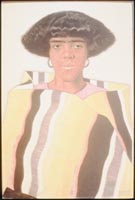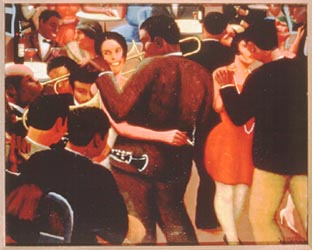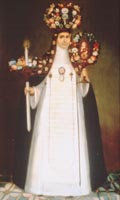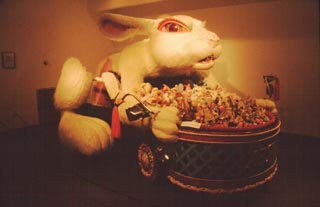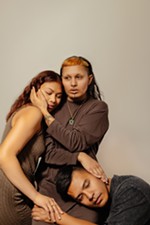Cultural Coolness Around Texas This Month
Fri., Dec. 18, 1998
Son of Art of the State '98
Rhapsodies in Black: The Art of the Harlem Renaissance
Museum of Fine Arts, Houston
|
|
In the United States, nowhere was the cultural boom more evident than in the northern Manhattan neighborhood of Harlem, where the black diaspora had gathered and reinvented itself in what we now know as the Harlem Renaissance. Energized by the new urban landscape into which they had moved, black Americans began to revolutionize the way they lived, adopting Booker T. Washington's turn of the century phrase "New Negro" to describe themselves. They began cultivating more sophisticated lifestyles based on the lighthearted aura of the time. More importantly, the community embraced and elevated the African and Caribbean ancestral roots that would come to characterize the exotic spirit of the Twenties. "Rhapsodies in Black: The Art of the Harlem Renaissance" is an exhibition at the Museum of Fine Arts, Houston featuring 100 works of art from the Twenties and early Thirties in Harlem. Houston is the exhibition's last stop on a tour that started at London's Hayward Gallery, then went to Bristol and Coventry, England, and on to San Francisco, Washington, D.C., and Los Angeles. Unlike some shows about the Harlem Renaissance that focus only on those artists working in the neighborhood, "Rhapsodies in Black" broadens the scope of the movement to include a world-wide collection of black and even white artists and performers who were adding to the new black experience.
To support this new perspective, a variety of media are represented, including film by Jean Renoir, jazz by Duke Ellington and Jelly Roll Morton, and rare footage of the Parisian vaudeville performer Josephine Baker. Photographer James VanDerZee documents the Harlem streets while Carl Van Vecten, a white New Yorker, adds a touch of celebrity with shots of Billie Holiday and the writer Zora Neale Hurston. On top of that, painters such as Aaron Douglas, who collaborated with the poet Langston Hughes on a few lithographs, and Archibald J. Motley Jr. represent both politically powerful images and lighthearted depictions of the jazz era nightlife.
The exhibition represents both a historical reminder of one of the great creative centers of this century in the United States and a fresh look at the people that made it happen. Certainly, with the whole world doing the Charleston in the Twenties, we can be sure it danced in Harlem for a night or two.
-- Sam Martin
"Rhapsodies in Black: The Art of the Harlem Renaissance" is on display through February 22 at the Museum of Fine Arts, Houston, 1001 Bissonnet. 713/639-7300.
|
|
The Rockefeller Center of Latin American Art
San Antonio Museum of Art, San Antonio
|
|
Rockefeller believed that art could establish friendships between the U.S. and the countries of Latin America. In 1940, as president of the Museum of Modern Art (MOMA) in New York, he had the museum exhibit 5,000 works of art borrowed from Mexican institutions to promote a better understanding of la Mexicanidad. The show, "Twenty Centuries of Mexican Art," broke all records at that time for the museum.
Rockefeller also acquired Latin American folk art, eventually amassing a collection of 3,000 pieces. Although the bulk of his collection includes utilitarian objects like candles, huaraches, saddles, and machetes, its span of almost 50 years offers an extraordinary survey of continuity and change in Mexican folk art.
In 1985, Rockefeller's oldest daughter, Anne Rockefeller Roberts, donated the collection to two institutions: the San Antonio Museum of Art in San Antonio, Texas and the Mexican Museum in San Francisco, California. In October of this year, the San Antonio museum opened a new 30,000-square-foot addition to house the 2,500 pieces in the collection. The Rockefeller Center, the first state-of-the-art facility in the nation devoted to Latin American art, includes an orientation gallery with six computer stations that run programs about the collection and Latin America, an atrium, and four galleries for pre-Columbian, Spanish colonial, folk, and modern art, each of which has distinct features that elegantly showcase and complement the works.
In his first meeting with the architects who designed the three-story $11 million addition to the historic former Lone Star Brewery, Marion Oettinger, Curator of Latin American Art at SAMoA, requested a barrel-vaulted ceiling in the gallery housing the primarily religious Spanish Colonial and Republican art of the 17th, 18th, and 19th centuries. "We didn't want to create a sacred space," says Oettinger. "But we wanted to create a space that's evocative of a sacred space."
Yet sacredness is certainly the feel of this gallery, one of the most spectacular galleries in the U.S., as well as the tall narrow atrium to which all four galleries connect. Positioned in front of the Spanish Colonial and Republican Art gallery and set into a niche near the roof of the atrium is a small contemporary stone statue of Nuestra Señora de San Juan de Los Lagos donated to the museum by a local antiquarian who is a big collector of virgen figures. Oettinger wanted something that would tie South Texas to northern Mexico and that image does it perfectly. All the beauty and greatness of el arte de Mexico is captured there in that small religious icon, as it evokes the large cathedrals of Mexico. "About two or three in the afternoon, when real strong sunlight comes through the skylight, it just lights her up," comments Oettinger. "And it's just beautiful. People cry."
|
|
Although most of the more than 200 paintings in the Colonial gallery are done in a popular style by anonymous artists, painters such as Juan Correa are included, and there is a small but important group of estofado images from Guatemala of Santa Teresa de Avila. Rounding out the display are secular textiles, furniture, and liturgical silver of which the silver incense burners in the shapes of animals are quite astonishing in their detail.
Combined with the folk art collection of Robert K. Winn, the fascinating and exquisite examples of pre-Columbian treasures from the Elizabeth Huth Coates collection, and the contemporary works, which include a Diego Rivera painting that was lost for 50 years, the center provides an excellent sampling of Latin American work spanning almost 4,000 years.
Even though several donors gave collections and contributions to create the center, for Oettinger, who has written a book on Rockefeller, it was clear from the beginning who the center should be named for. "We asked the family if we could use the name, partly because of the gift of the collection and also because they made a very significant contribution to the capital campaign to build the center. But primarily the reason we named the center for Rockefeller is because at a time when the U.S. and the art community was saying that this stuff 'que no tiene nada de valor, nada' Rockefeller was in the trenches fighting. He was on the board of MOMA in New York in the Thirties and still MOMA turned away every gift of pre-Columbian art, [saying] 'que no es arte.' But he was behind that great monumental exhibit in 1940 at MOMA and they did a bilingual catalog. A bilingual catalog! Who ever heard of such a thing in 1940? That's the kind of thing we're celebrating and honoring here by naming the center after him." -- Mary Jane Garza
The Nelson A. Rockefeller Center for Latin American Art is located in the San Antonio Museum of Art, 200 Jones Ave., San Antonio. 210/978-8100.
A Pør Quinly Christmas
The Undermain Theatre, Dallas
The Undermain Theatre thrives underground in Dallas' Deep Ellum district, staging plays in a basement space that exists, literally, under Main (Main Street, that is). The insightful, modern, often cutting edge work of this trailblazing company makes it one of the hottest non-traditional theatres in Texas. Attracting gifted writers from around the country and sometimes from the far corners of the globe, the Undermain Theatre continues to stretch the boundaries of theatre in its subterranean grotto.
It should come as no surprise, then, that when the Undermainers opt to mount a Christmas show, it reflects some of the wackier, less traditional aspects of this sometimes too predictable holiday season. While you could seek out the numerous Metroplex Scrooges tearing at their hair on various area stages (there are reportedly quite a number of Victorian curmudgeons on parade this year), you might fare better by going underground for a taste ofA Pør QuinlyChristmas, by New York playwright Quincy Long.
Last year's unexpectedly successful antidote to the sugar plums of the holiday season is back, entertaining families with an Undermainish twist on all you'd expect from a Christmas pageant in terms of song, dance, bright lights, and a simple story of the search for the meaning of Christmas. Back in a new-and-improved package are Bryan Wofford's bold, colorful design mocking 1950s Christmas cards, plenty of song and dance, and a vein of sophisticated humor to keep the adults as entertained as the wee folk.
Pør Quinly is a little boy, whose father has gone missing. Pop's anti-Christmas rhetoric, disparaging the commercial side of the Yuletide, has rubbed off on young Quinly, himself now an Unbeliever in the magic of the season. Befriended by a talking Christmas tree, poor little Pør sets off to find his pa, encountering various strange and beautiful folk along the way. Well, perhaps not all that beautiful. Among the pleasant Snow People lurks a thug, as well as the villainous Dr. Shopperlifter, who turns good shoppers into mannequins. And where does Tree take young Quinly for this much-needed lesson on the beauty of the season? Why to the Mall, of course!
Stocking Stuffer Bonus!!! Undermain co-artistic director Raphael Perry -- one of Big D's shining talents onstage and off -- makes his singing debut (after all this time, he's never sung onstage before?) as the evil scientist Dr. Shopperlifter. The whole cast, composed of Undermain regulars and a few local favorites, should bring joy to the world, if not the basement, for this touching, clever Christmas treat. -- Robi Polgar
A Pør Quinly Christmas runs through December 20, Wed-Sun, at the Undermain Theatre, 3200 Main (three blocks south of Baylor Hospital in Deep Ellum), Dallas. 214/747-5515.
Art Car Museum
Houston
|
|
Are you ready for a new aesthetic experience? A quintessentially Tex-Mex American showcase for cars that have been dressed up, fussed over, painted, re-shaped, assemblaged, decoupaged, and entirely smothered in plastic and metal flotsam and jetsam that floated to the surface of this soon-to-be-ended 20th century?
Yes? Well, then, have I got a museum for you!
The Art Car Museum on Heights Boulevard in Houston is the only museum of its kind in the world. Even without the address, it's hard to miss the building's chrome-plated, aerodynamic exterior thrusting skyward in an otherwise low-profile neighborhood.
Modest in size but totally flamboyant in design and intent, this little gem includes three small galleries with changing exhibitions. Currently on display are photographs: Vehicles of Havana, by Irvin Tepper, Private Rituals, by Dick Craig, and Bicycles to Bosnia: An Art Car Project. There is also a showroom filled with eye-blinding examples of the art car genre. These include: a beauty called Mona Lupe, a 1976 Cadillac Sedan DeVille with airbrushed image by San Antonio artist Cesar Martinez; Rex Rabbit, a 1984 VW Rabbit (what else?) Diesel to which California car maestro Larry Fuente has added a huge white rabbit with beady pink eyes and menacing leer; and Swamp Mutha, a 1982 Chevy Monte Carlo created by Ann W. Harithas, artist and founding mother of the museum.
Harithas is an articulate proponent of what she describes in the book Art Cars as a fine art "essentially free of the conventions and contradictions of the marketplace and the art world." Her husband, James Harithas, formerly the founding director of Houston's Contemporary Arts Museum, writes: "All art cars are subversive and have in common the transformation of the vehicle from a factory-made commodity into a personal statement or expression." The couple's Ineri Foundation opened the museum early this year, closed it briefly to add air conditioning, then re-opened it last month.
The idea for the museum grew out of the annual Houston Art Car Parade. Championed by the Orange Show Foundation (itself organized to preserve a visionary/folk art installation by the late great untrained artist Jeff McKissack), the parade grew from a gathering of 40 art cars in 1987 to around 300 last year, with participants drawn from around the country and beyond.
Now, all those rolling examples of free enterprise and aesthetics have a home of their own year-round. According to the garrulous guy in the orange Hawaiian shirt and Art Car Museum gimme cap (available in the closet-size gift shop) who sits at the museum's front desk, the cars on exhibition will change from time to time, as will the works in the small galleries. And if you're curious about past parades, Andy Mann's "Art Car Matrix" -- nine TV screens stacked roughly in the shape of a car -- offers an ingenious video kaleidoscope from the last 10 years of the event.
The stand-out car (or at least one of the most complex) in the gallery is Faith, a 1984 Camaro made over by California sculptor David Best (Mixed Media: Cape Buffalo head, ceramics, metal, glass, plastics). It received the Best of Show Award at the 1997 Houston Art Car Parade. Best, who has created some 12 different art cars and one bus, was asked about the reactions that his cars get from people when he drives them on the street. He says, "Ninety percent of the people love a decorated car, five percent hate it ... and five percent act as if it doesn't exist, they're oblivious to it. I can understand hostility because we live in a hostile environment. But that other five percent really mystifies me."
I would be mystified as well if heads didn't turn as one of these cars tooled on down the road, and if your head isn't turned by a visit to Houston's newest art museum.
-- Rebecca S. Cohen
The Houston Art Car Museum is located at 140 Heights Blvd., Houston. 713/861-5526
This month, you don't need a reason to travel; you have family in San Antonio or Houston or Dallas, and they expect you there for the holidays. That's reason enough. No, what you need this month is a reason to get out of the house you have traveled to. Once you've done all the hall-decking and the eggnog and the whole fa la la la la, when the football fans have claimed the TV and the annual dissection of every family member's life is about to turn your way, you need that great excuse to leave the premises for a few hours. That's where we come in. The Chronicle arts writers have surveyed the state and found some cultural activity in our Lone Star neighbors that are more than sufficient cause for taking a powder from the family manse -- hell, they're reason enough to visit one of these cities even if you don't have family there. So pack a copy of these listings with you when you go traveling to see the relatives.
-- Robert Faires
Theatre
THEATRE THREE: THE MISER Dallas stage company finds a different miser to throw onstage at Christmas. This version relocates the Moliere comedy to New Orleans in 1875. Jac Alder directs. Through Jan 10, Tue-Thu, 7:30pm, Fri & Sat, 8pm, Sat & Sun, 2:30pm. $5-25. 2800 Routh. 214/871-3300.
STAGE WEST THEATRE: THE CHRISTMAS MYSTERIES Fort Worth company goes Biblical big-time, dramatizing the Good Book from the fall of Lucifer to the birth of Christ. Nicolas Sandy's adaptation utilizes farce, music, dance, and clowning. Through Dec 27, Thu & Sun, 7:30pm, Fri, 8pm, Sat, 3 & 8pm. $14-18. 3055 S University, Fort Worth. 817/784-9378.
JUBILEE THEATRE: THE SHO-NUF BLUES The work of musical pioneer W.C. Handy celebrated in a revue. Through Jan 3, Fri & Sat, 8:15pm; Sat & Sun, 3:15pm. $12-16. Jubilee Theatre, 506 Main, Fort Worth. 817/338-4411.
STAGES REPERTORY: FUNNY GIRL Houston company re-creates Fanny Brice's rise to fame, as imagined in Jules Styne's musical version. Through Jan 3, Wed-Sat, 8pm, Sun, 3pm. $10-30. 3201 Allen Pkwy, Houston. 713/527-0240.
JOSEPHINE THEATRE: THE MUSIC MAN San Antonio stage company stirs up trouble in River City with this revival of Meredith Willson's charming musical. Through Jan 10, Fri & Sat, 8:15pm, Sun, 2:30pm. $17. Josephine Theatre, 339 W. Josephine, San Antonio. 210/734-4646.
SAN ANTONIO PUBLIC THEATRE: A CHRISTMAS CAROL Alamo City independent theatre company takes the traditional Yuletide route with another staging of Charles Dickens' ghost story of Christmas. David Connelly directs. Through Dec 20, Thu-Sat, 8pm, Sun, 2:30pm. $10. Attic II Theatre, Trinity University, 715 Stadium, San Antonio. 210/829-7529.
Dance
FORT WORTH DALLAS BALLET: THE NUTCRACKER Metroplex dance company serves up all the sugar plums you can handle in the traditional holiday ballet, score by Tchaikovsky. Choreography by Benjamin Houk. Dec 21-24, Mon-Wed, 8pm, Tue-Thu, 2pm. $8.25-41. Fair Park Music Hall, First & Parry, Dallas. 972/647-5700.
HOUSTON BALLET: THE NUTCRACKERBayou City ballet favorites return to the seasonal staple that has served them so well through the years. Score by Tchaikovsky, as you know, choreography by Ben Stevenson. Through Dec 27. $10-60. Brown Theater, Wortham Center, Texas & Smith, Houston. 800/828-2787.
Art
ARLINGTON MUSEUM OF ART "Texas Roots + German Figures," concurrent exhibitions featuring works by Mary Elizabeth Nye and Jay Bergstrom, through January 2. 201 W Main, Arlington. 817/275-4600.
ART MUSEUM OF SOUTH TEXAS "Grandpa's Attic," an installation by members of the community, in which the third floor of the museum is transformed into a miniature forest of Christmas trees within an attic filled with treasures, through December 24; "AMST Collects Narrative Art," selections from the museum's permanent collection, through May 30. 1902 N. Shoreline, Corpus Christi. 512/980-3500.
DALLAS MUSEUM OF ART "The World of William Joyce," original illustrations by the author/artist of the children's books Santa Calls, Dinosaur Bob, and The Leaf Men, through January 3; "The Jewels of Lalique," one of the most comprehensive exhibitions of drawings, jewelry, and other works by René Lalique, through January 10; "Concentrations 32: Anne Chu and Bonnie Colura," sculptures by two emerging artists, through January 17; and "Quilts and Coverlets: Off the Bed and on the Wall," selections from the museum's permanent collection, through February 7. 1717 North Harwood, Dallas. 214/922-1200.
AMON CARTER MUSEUM "Masterworks of Photography Collection: Picturing Modern Life," an exhibition of photographs spanning the entire history of the medium, from the 1840s through the present, through January 3; "Self-Taught Artists of the 20th Century: An American Anthology," an exhibition of 250 paintings, installations, and sculptures by 32 artists who have developed their style outside the established art world, presented jointly with the Modern Art Museum of Fort Worth, through January 24. 3501 Camp Bowie Blvd., Fort Worth. 817/738-1933.
KIMBELL ART MUSEUM "Guests of Honor: Masterpieces by Caspar David Friedrich," an exhibition of paintings by the German Romantic landscape painter from the Nationalgalerie, Berlin, and Museum Folkwang, Essen, through January 17; "Self-Taught Artists of the 20th Century: An American Anthology," an exhibition of 250 paintings, installations, and sculptures by 32 artists who developed their style outside the established art world, presented jointly with the Modern Art Museum of Fort Worth, through January 24. 3333 Camp Bowie Blvd., Fort Worth. 817/332-8451.
GALVESTON ARTS CENTER "Jean Carruthers Wetta: A Survey 1984-1998," an exhibition of works by the onetime Galveston artist, through January 10; and "Marilyn Brodwick: Aging," photographs focusing on the way we age. 2127 Strand, Galveston. 409/763-2403.





